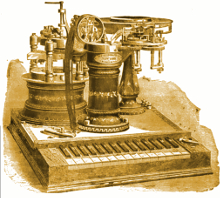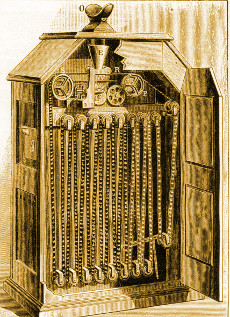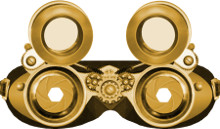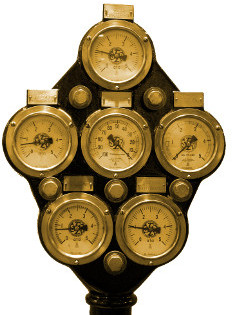
A mechanism is any device or apparatus that implements the principles of mechanics in its basic functions for practical or experimental use. Automatic machines are becoming increasingly common, and these include clockwork devices, flying machines, analytical engines, locomobiles, and automatons. Many of these are magical in some way, incorporating aetheric energy sources, alchemical metals, or empowerments. More ordinary and everyday mechanisms are powered by clockworks, pneumatics, steam engines, ichor engines, and similar power sources.
Clocks and Pocket Watches
Clocks are among the oldest kind of automated mechanical devices. The knowledge of making clocks and clockworks was never lost after the fall of Marada; all machines built during the Age of the Three Realms and through the present day are based on clockwork technology. Larger and older-style pendulum clocks may cost anywhere from one or two guilds to fifteen guilds or more. A common pocket watch typically runs two or three guilds, but can cost up to ten guilds for gold-plated, fine-quality pocket watches. A ship’s chronometer, which is built to exact specifications and high tolerances, may cost as little as five guilds or upwards of twenty guilds for chronometer consoles that include a compass, barometer, thermometer, and altimeter (on airship models).
Clockwork Toys
Clockwork toys, trinkets, and curios have been common since the Age of the Three Realms. They remain popular with both children and adults alike in the present day. These may be simple or highly complex clockworks, and they may include such things as clockwork toy vehicles, mechanical dolls, and self-spinning tops. They usually cost anywhere from less than half a guild to ten guilds or more, depending on complexity.
Music Boxes
Music boxes are intricate clockwork devices that produce music. Depending on the kind of music box, they may use tiny bells, strings, or even pneumatics to produce a variety of notes and tunes. Although some can only produce a handful of songs, larger ones have exchangeable cylinders or disks, allowing them to play hundreds of different compositions. Music boxes range in price from two guilds to twenty guilds or more for the “orchestral box,” which is said to reproduce the sound of a (very small) orchestra.
Automatronic Instruments
A step above all but most advanced music boxes are fully automated instruments. Automated instruments include self-playing pianos, steam organs, clockwork armonicas, pneumatic horns and trumpets, mechanical drums, and automatronic violins. Individual automatic instruments cost anywhere from ten to thirty guilds apiece, and a small 36-piece orchestra set can cost between 700 and 1000 guild, which makes them affordable only to nobility and wealthy merchant families. Like music boxes, automatic instruments reproduce countless music pieces by the exchange of their program cylinders.
Kinetoscopes

Kinetoscopes are elaborate machines that are designed to play a reel of images in rapid succession, providing the illusion of a “moving image,” which is sometimes accompanied by music from a music box. The viewer can watch these moving images through a small window, scope, or portal. Larger kinetoscope models allow up to four seated individuals to view the same moving picture at once. A typical kinetoscope image-play runs between five and fifteen minutes, but one– and two-hour reels are also possible. Although true magical illusions are far superior, kinetoscopes and their reels can be mass produced and are becoming more and more common in major cities. Corradon has over thirty kinetoscope galleries, and that number is growing every day. Experiments are currently being conducted to test projected kinetoscope images on large screens for larger audiences. A single kinetoscope for individual viewing can cost anywhere from ten to thirty guilds.
Advanced Gadgetry
Advanced gadgetry is made up of the assorted devices, apparatuses, instruments, and contrivances that are not in general use. They are built and used by those “conjurers of machines” who are more generally termed gearmeisters. Gearmeister is a special vocation in and of itself, but can also include analytical mechanics and machinists, innovative investigators, combat engineers, and anyone else possessing the skill, wit, and cleverness to repurpose even the most innocuous clockwork toy to an automated hunter-killer attack drone.
Ocular Devices

Ocular devices include any number of goggles, spectacles, monocles, and visors equipped with multiple lenses, optical magnifiers, light amplifiers, spectrum crystals, or enchanted lenses. Depending on the number and kind of lenses, crystals, and other components, an ocular device may allow for telescopic sight, microscopic sight, night vision, or higher or lower visible spectrums. Some may even allow one to see auras, ghosts, or vibrations in the aether. Because of the wide variety of ocular devices that can be made available, they can cost anywhere from 10 to 500 guilds. Most gearmeisters simply construct their own.
Clockwork Locks
The most advanced locks available in the modern age utilize complex clockwork locking mechanisms rather than the older warded locks or common pin-and-tumbler locks. There are two general kinds of clockwork locks: dial locks and paired locks. The dial lock appears similar to a dial on a safe, but it is much more complex. Often, it contains three or four rings that must each be turned separately through a series of four or five numbers, for a total of between twelve– and twenty-number combinations (though they can sometimes be alphanumeric or symbolic combinations). The paired lock is even more complex, but also much more secure. It requires a clockwork key (usually tube-shaped) that must interface with the clockwork lock. The clockwork key has one or more dials, which the key holder must use to dial the correct combination before he can stick it in the lock. Both are impossible to crack using traditional lock picking, but both can be cracked with an auto-rotor. Gearmeisters do not generally use clockwork locks, but are proficient at cracking them. Clockwork dial locks can cost anywhere from ten to fifty guilds, depending on whether the lock is for a door, a chest, or a large bank vault. Clockwork paired locks can cost anywhere from 30 to 500 guilds, depending on complexity.
Autotumblers
The autotumbler is a lock-picking device used by those lacking in traditional lock picking skills. It is a small clockwork cylinder with a swappable set of picks and a torque wrench. When used, the autotumbler vibrates the pick rapidly while rotating the torque wrench. Some skill is needed to use the autotumbler, as the settings on it need to be adjusted for different types of locks, but it is generally much faster than manual lock picking. The autotumbler cannot pick clockwork locks. Typical autotumblers cost between five and ten guild, but more advanced autotumblers, which are used to defeat larger or more secure tumbler locks, can cost up to fifty guilds.
Autorotors
The autorotor is one of the signature tools of a gearmeister. Most autorotors take the form of a cylinder or box weighing three to five pounds, but larger and more complex autorotors do exist. The device itself is a kind of automaton. It does not have arms or legs or instructions to mimic human behavior, but it is a specialized automaton that is designed for the singular task of melding itself to any geared device and overriding its operation. While originally a tool used by mechanics and engineers to diagnose problems in clockwork machines, gearmeisters have found more creative uses for it. Equipped with adjustable sets of adaptive gears, the autorotor allows the gearmeister or mechanic to override the normal operation of a clockwork mechanism, assuming that he has access to its gears. The most common use of autorotors is cracking clockwork locks, but they can also be used to override and control automatons, analytical engines, clockwork engines, and other clockwork devices. Autorotors require a great deal of specialized skill and a deep knowledge of clockwork mechanics. Because of this, they are not in common use. They can cost anywhere from 100 to 500 guilds on the black market. Most gearmeisters usually construct their own.
Mechanical Tools
While traditional tools such as hammers, wrenches, spanners, pliers, and screwdrivers are by far the most common kind of tool to be found, mechanical tools also exist. Sometimes called automatic tools or pneumatic tools (if driven by pneumatics), these include bolt guns, auto-drivers, powered drills, pneumatic hammers, multi-spanners, and any other tools driven by clockworks, machinery, or compressed air. They are used by mechanics, machinists, and engineers, but are favored by gearmeisters. Most mechanical tools cost between two and ten guilds, depending on the kind of tool and its complexity.
Advanced Gauges and Instruments

Although many machines, engines, and vehicles have gauges to display pressure, temperature, and rotation speed, among other things, most are primitive and only passingly accurate. The more advanced gauges and instruments include coil thermometers, barometers, odometers, altimeters, vibrometers, optometers, phonometers, gyro-compasses, torque gauges, and electric gauges. Advanced instruments also include those that are in some way magical or enchanted and include aether-sensitive components such as aetherometers (aetheric resonance and pattern detectors), vivometers (life detectors), necrometers (ghost and undead detectors), thaumatometers (magic detectors), and psychometers (detection of mental states, emotions, and psychic energy). Although many of these devices are quite large, some can be made very small by using the most advanced clockworks and miniaturized components available. The multi-gauge, for instance, is a compact device that is often worn on the arm or on a belt and combines four or five gauges into one complex mechanism. They are quite popular with gearmeisters, Dworghs, and engineers. Such multi-gauges typically include a watch, a coil thermometer, a barometer, an altimeter, and two or three specialized gauges or instruments depending on preference and need. Advanced gauges and instruments cost anywhere from two to ten guilds, though magically enhanced gauges can cost fifty guilds or more. A multi-gauge costs between twenty and fifty guilds, though if it incorporates several magically enhanced gauges, it can cost as much as 200 or 300 guilds.
Pneumatics
Although pneumatics are not the most efficient form of power available, they are favored for small devices and machines due to their compact size and simplicity. Batteries and clockworks are both costly and unreliable, and the electrical power from batteries must be converted to mechanical power. Pneumatics, in the form of compressed air, can be used to drive many kinds of small devices, including auto-tumblers, auto-rotors, multi-spanners, pneumatic hammers, and bolt guns, as well as portable enumerators and small automatons. Pneumatics are also used to power various kinds of clockwork weapons. Some devices come with their own small pneumatic tank. Gearmeisters generally carry either several small pneumatic tanks or one large pneumatic tank to power their devices.
Calculating Machines
Calculating machines were widely used in the Age of Marada and known as “computaters.”From the remains of these remarkable computaters, modern-day calculating machines have been devised. The earliest calculating machines of the current era were built by artisans of the Three Realms. These machines were mostly clockwork mechanisms that were comprised of gears arranged in such a way that by rotating them, they carry decimals and fractions up and down their respective place values. The more gears the device had, the more place values were possible. By winding different gears on the device or continuously winding the main gear, numbers could be added and subtracted relatively quickly. More advanced gears and sets of stepping cogs allow for multiplication and division, as well. Countless derivatives of these devices have been built, and they have been known by many names, such as “the Solver” or “the Reckoner,” or by the name of the inventor, such as the Morrnali Mathematics Mill.
Large calculating machines are now powered by steam engines or electric motors and are costly due to the high level of craftsmanship involved in creating them. Calculating machines, also called enumerators, can often be found on ships for calculating longitude or on the battlefield for calculating artillery trajectories.
Analytical Engines
Heralded as the engines that will change the world, analytical engines are not merely a step above calculating machines; they are the culmination of all the science, engineering, mathematics, and ingenuity accumulated since the fall of Marada.

As early as the 750s CA, inventors and mathematicians were tinkering with the basic ideas that would be later drawn together by the first true analytical engineers. Many of the concepts for analytical engines originated from the work of the famed gearmage Telasar.
Today, analytical engines are capable of performing any mathematical operation, procedure, or algorithmic sequence. They can maintain information in mnemonic registers, perform calculations in their analytic mills, receive input from a punched card or tape reel, and either display results on gauges or print them on ticker tape, printing presses, or punch cards. Instructions from the punch-card decks, similar to those used in textile looms, or single long reel would then direct the machine on what operations to perform and in what order and provide all relevant number values. The average analytical engine has a memory capacity of 1,000 30-digit numbers and can draw upon auxiliary functions such as logarithm tables and subroutines from its internal library of cards or reels. The most advanced machines are even capable of using logical condition statements to perform algorithmic branching or make “decisions.”
Most analytical engines can be found in universities, military bases (for cryptography), banks (for money counting), and mathematics shops, where logarithms are tabulated and sold. Analytical engines can also be found in the holdings of mercantiles, nobles, guilds, and astrological observatories. Smaller analytical engines may be used on ships for navigation and other functions. Although the smallest analytical engines weigh only a few hundred pounds and take up the space of table, a typical analytical engine is about ten tons and takes up the space of entire room. A typical analytical engine requires a substantial power source and constant maintenance.
A few possible uses of analytical engines are
- Performing any math function
- Printing tables of logarithms
- Printing astrological ephemeris books
- Performing interest-rate calculations
- Maintaining accounting records
- Formulating music from algorithms
- Ciphering or encoding messages
- Analyzing and breaking ciphers
- Controlling automatons or music boxes
- Analyzing data for patterns
- Translating languages (this requires a library of words)
Automatons

Most automatons are simple clockwork devices that perform singular tasks. More complex automatons have advanced analytical engines, optographic eyes, dexterous arms, and a phonographic register that allows them to discern sounds. Automatons can perform tasks, such as playing a piano or other musical instrument, shuffling and dealing cards, or “telling” jokes and stories. Most are powered by clockworks, pneumatics, or batteries, and they are controlled by a mechanical enumerator with punch cards or punch tape reels.
If they are mobile, they will have wheels or sit in motorize wheelchairs.
More complex automatons have advanced analytical engines, optographic eyes, dexterous arms, and a phonographic register that allows them to discern sounds. They may carry ten to twenty programs on reels of punch tape, which they can switch out as situations change. These advanced automatons can walk, but will walk stiffly and ponderously, and can either follow a designated person or use a map reels to find a preset destination. They may also have a voice reel that can have up to twenty preset statements or questions, and a command reel that can recognize up to twenty preset commands. The commands must be selected using switches or buttons.
The most advanced automatons have greater dexterity, can walk with a smoother gait, and display a very rudimentary level intelligence. These advanced automatons can follow more complex instructions, can adapt to a wider range of situations, and can even follow simple voice commands to carry out functions within their defined parameters.